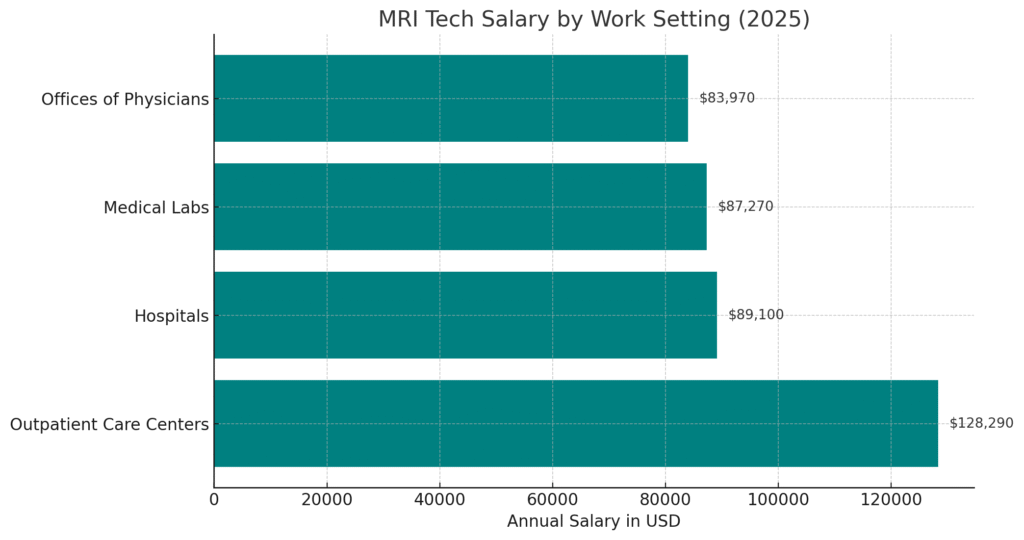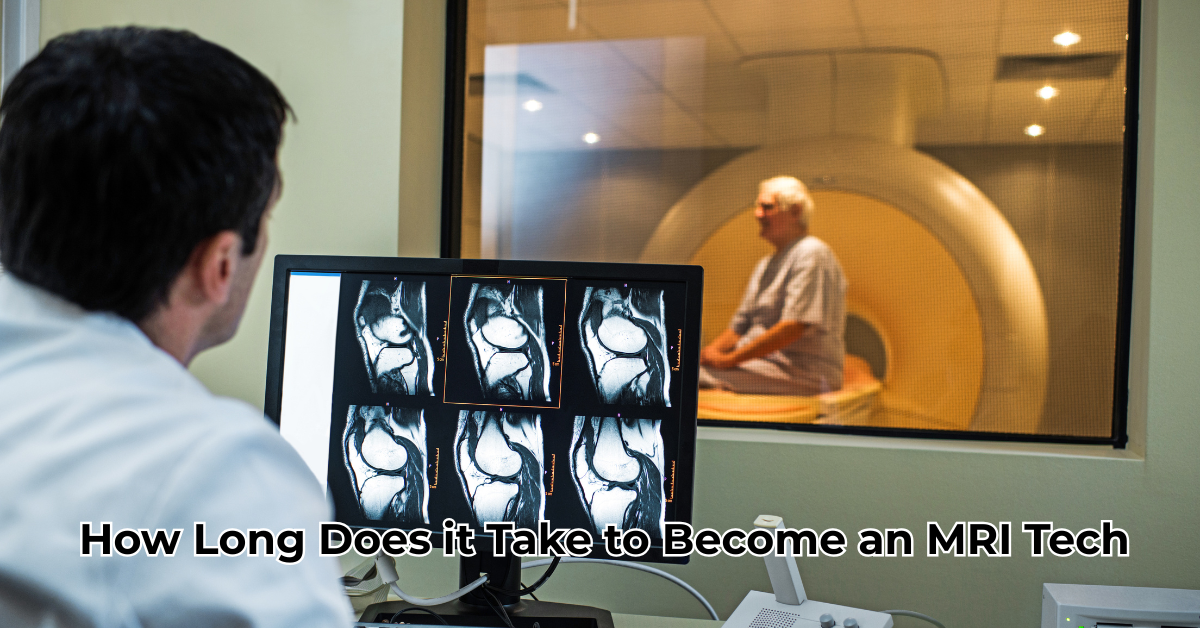Magnetic Resonance Imaging (MRI) technologists have become an essential part of healthcare today, as they ensure that detailed images of the body are captured, and doctors diagnose and treat numerous health issues.
As the need for performance image technology in hospitals, clinics, and diagnostic centers increases, becoming an MRI tech is an attractive and satisfying career decision. However, when entering this profession, a significant question on the minds of most aspiring individuals is: how long does it take to become an MRI technologist?
Becoming a qualified MRI technologist is a process that combines both education and practical training and qualification. In this paper, we shall deconstruct every step, discuss the chronology, and give an idea of what you can expect out of this career choice.
The first step toward a career in this highly sought-after field of healthcare is to know how the process works, regardless of whether you are fresh out of high school or looking to change your career path.
Step 1: Educational Requirements for MRI Technologists
The initial process of becoming an MRI tech is to get the proper education. The majority of MRI technologists typically begin with a high school diploma or its equivalent, which often includes science classes such as biology, chemistry, and physics. These topics compose the basis of anatomical, physiological, and technical imaging.
After high school, aspiring MRI techs typically choose between three main educational paths:
- Associate Degree in Radiologic Technology or MRI : Usually takes 1.5 to 2 years to complete and is the most common path. Programs include both classroom instruction and clinical rotations.
- Bachelor’s Degree in Radiologic Sciences : This degree takes approximately 4 years and offers a more in-depth education, often including advanced imaging techniques and management courses.
- Certificate or Post-Secondary MRI Program : Ideal for those who already hold a degree in a related healthcare field. These programs generally take 12 to 18 months and focus on MRI-specific training.
Most employers prefer candidates who have completed an accredited program, as this ensures you have the necessary knowledge and clinical experience to operate MRI machines safely and effectively.
Selecting a program accredited by the Joint Review Committee on Education in Radiologic Technology (JRCERT) or a similar recognized body is crucial for meeting certification requirements later in your career.
Step 2: MRI Tech Certification and Training Programs
After completing the educational requirements, the next step is to enroll in an MRI technician certification and training program. These programs are designed to provide hands-on experience, teaching you how to operate MRI machines, position patients, and ensure image quality while maintaining safety standards.
The majority of MRI programs include classroom learning with clinical rotations, which provide students with practical experience in a hospital or imaging facility.

The clinical part can be 6 or 12 months in duration and differs according to the program; however, you can work under the supervision of experienced technologists. The skills you will acquire during this time period include patient care, safety measures and protocols, anatomy, and image interpretation.
The accredited programs are also crucial since they qualify you to take certification exams, without which you cannot practice as a professional MRI technologist. Professional organizations, such as the American Registry of Radiologic Technologists (ARRT), provide recognized certification. By completing an accredited program, you are likely to meet their eligibility requirements.
Step 3: Timeframe to Complete MRI Tech Training
One of the most common questions is: How long does it actually take to become an MRI tech? The answer depends on the educational path you choose:
- Associate Degree Path : Typically takes 18 to 24 months for full-time students. Part-time options may extend the timeline to 2.5–3 years.
- Bachelor’s Degree Path : Takes approximately 4 years, including both general education and advanced imaging courses.
- Certificate Program Path : Designed for those with prior healthcare education, usually completed in 12 to 18 months.
Keep in mind that completing your formal education is only part of the journey. You will also need to pass certification exams, which can take several additional months, including preparation and scheduling time.
On average, the total time from starting your program to becoming a fully certified MRI technologist ranges from 1.5 to 4.5 years, depending on your chosen path and pace of study.
Step 4: Licensing and Certification Process
Once you complete an accredited MRI program, the next critical step is obtaining certification and licensure. In the United States, most employers require MRI technologists to be certified by the American Registry of Radiologic Technologists (ARRT).
To earn ARRT certification, you must:
- Graduated from an accredited MRI program.
- Complete a minimum of 16 credit hours of professional education related to MRI.
- Pass the ARRT MRI certification exam, which consists of 220 multiple-choice questions covering patient care, safety, imaging procedures, and anatomy.
The cost of the exam is typically around $200–$300, and candidates must also pay a $75 annual registration fee to maintain certification. Once certified, many states also require a state license, which may involve additional fees or continuing education credits.
Certification not only validates your skills but also increases job prospects and earning potential, making it a crucial step in your MRI tech career. Most technologists become fully certified within 3 to 6 months after completing their educational program, depending on exam preparation and scheduling.
Step 5: Career Outlook and MRI Tech Salary
MRI techs have an up-and-coming career prospect because of increased diagnostic imaging needs. The Bureau of Labor Statistics predicts a 9 percent increase in the number of people who use MRI within the occupation between 2023 and 2033, a faster growth than that of all jobs.
The primary employers are hospitals, outpatient clinics, and diagnostic imaging centers, with additional opportunities emerging in specialized medical centers.

In terms of salary, MRI technologists receive a good percentage depending on the years of experience, location, and workplace:
- Average Salary in the U.S.: Around $75,000 per year.
- Top-paying states: California ($97,000), Texas ($84,000), and New York ($92,000).
- Entry-level salary: Approximately $55,000–$60,000 per year.
Other perks common to the profession are health insurance, retirement schemes, and overtime opportunities, so it is a stable yet profitable profession. With experience, MRI technologists can seek higher positions, supervisor positions, or allow them to specialise in such fields as cardiac or neuroimaging, which may also increase income.
Step 6: Comparing MRI Tech Careers with Other Medical Imaging Careers
While MRI technologists are highly specialized, it’s helpful to understand how this career compares with other medical imaging professions. Common alternatives include CT (Computed Tomography) technologists, ultrasound techs, and X-ray technologists.
- CT Technologists – Typically complete a similar educational path (1.5–4 years) but focus on CT scans. Salaries average around $70,000 per year, slightly lower than those of MRI techs in many regions.
- Ultrasound Technologists – Usually require an associate degree or certificate program (2 years), with an average salary of $75,000 per year. Ultrasound techs perform imaging using sound waves, which is non-invasive and radiation-free.
- X-Ray Technologists – Often complete a 2-year associate degree, with salaries averaging $60,000–$65,000 per year. X-ray techs work in hospitals and clinics performing general imaging.
Compared to these roles, MRI technologists often enjoy higher salaries, specialized skills, and more career growth opportunities. Additionally, MRI techs work with cutting-edge imaging technology, which can be appealing for those interested in advanced diagnostics.
Final Words
To be an MRI technologist, one needs to take a special educational course, practical training, and certification, yet the payoffs are high. The average time of the journey is 1.5-4.5 years, based on the program and speed of your choice.
It is a favorite profession to pursue for anyone interested in healthcare and medical imaging, as this field offers competitive salaries, high job growth, and opportunities for specialization.
Through proper education, training, and certification, you can launch a rewarding career assisting doctors in diagnosing and treating patients, and work in a stable, high-demand field that utilizes advanced technology.
And whether this is your first step in the career ladder or you are thinking of a career change, becoming an MRI tech is one career that will not only offer you technical skills and patient care, but also rewarding financial opportunities, thus making it a career to think about.
FAQs
How long does it take to learn MRI?
It typically takes 1.5 to 4.5 years to become an MRI technologist, depending on whether you pursue a certificate, associate, or bachelor’s degree program.
What is the highest salary for an MRI tech?
The highest MRI techs can earn over $120,000 per year, especially in outpatient care centers or specialized facilities.

